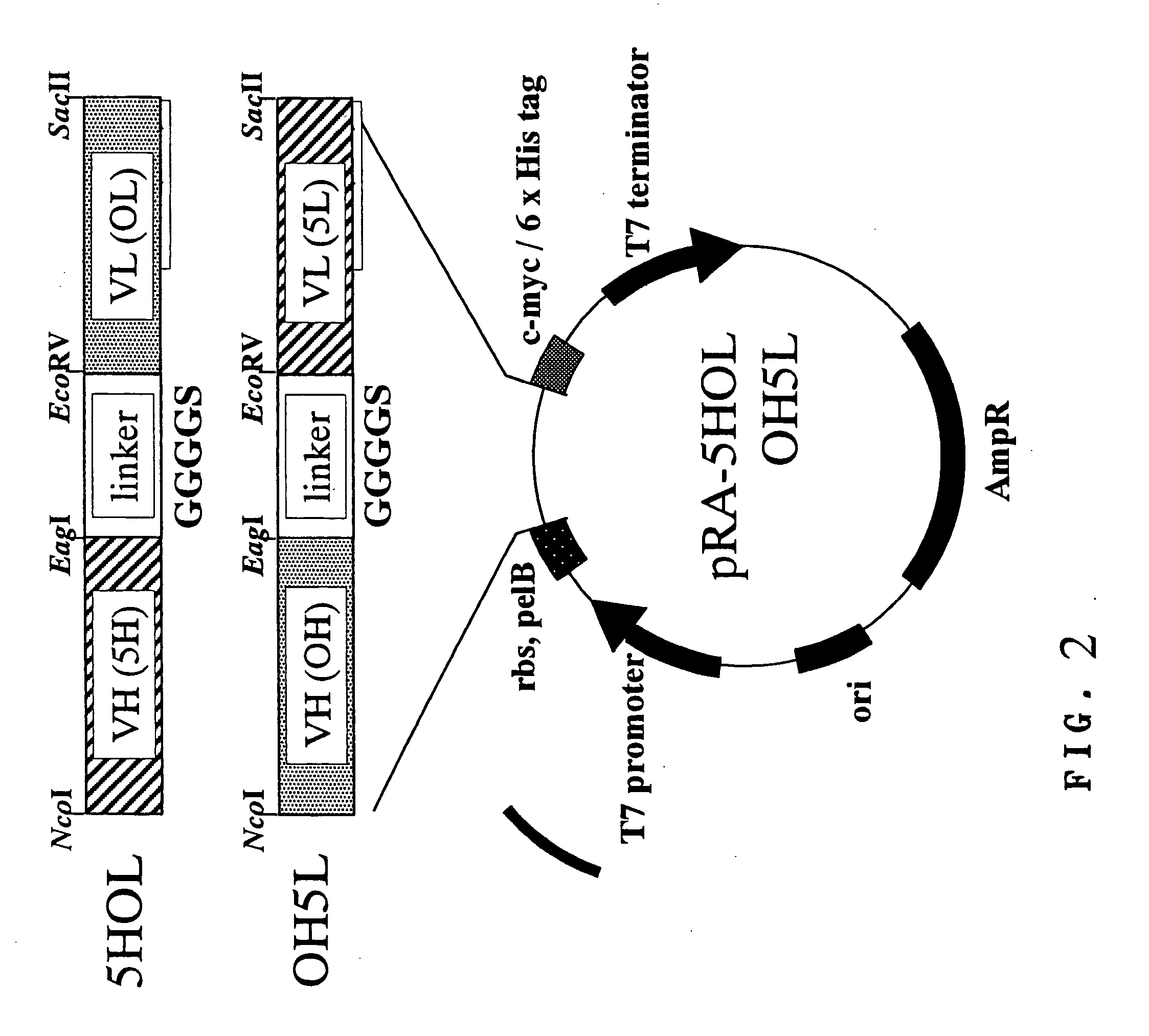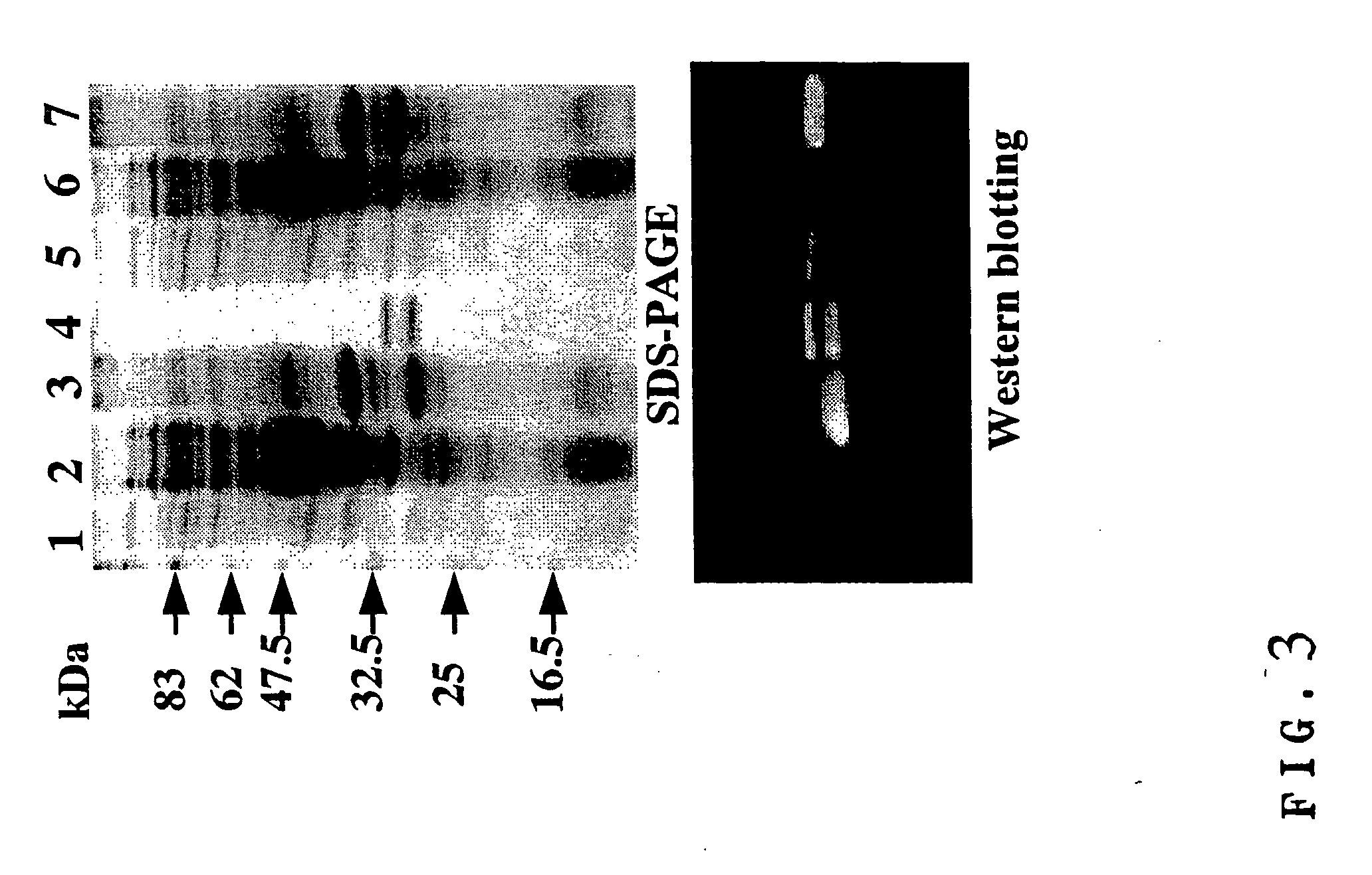Novel diabody-type bispecific antibody
a bispecific antibody and diabody technology, applied in the field of new diabody-type bispecific antibodies, can solve the problems of inferior effectiveness and stability, and achieve the effect of increasing the production of cytokines
- Summary
- Abstract
- Description
- Claims
- Application Information
AI Technical Summary
Benefits of technology
Problems solved by technology
Method used
Image
Examples
example 1
Cloning of Anti-Epidermal Growth Factor Receptor Antibody
[0105] Mouse B cell hybridoma 528 producing anti-EGFR antibody was provided by Cell Resource Center for Biomedical Research, Institute of Development, Aging and Cancer, TOHOKU University. mRNA was extracted with ISOGEN (Nippon Gene Co.) and then cDNA was prepared by means of First-Strand cDNA Synthesis Kit (Amersham Biosciences Co.). PCR reaction was done for the cDNA using cloning primers that were synthesized based on Reference 1 to determine the sequences of variable regions of 528, VH (referred to as “5H”) and VL (referred to as “5L”)(FIG. 1). [0106] Reference 1: Kr ebber, A. et al. Reliable cloning of functional antibody variable domains from hybridomas and spleen cell repertoires employing a reengineered phage display system. J Immunol Methods 201, 35-55. (1997).
example 2
Preparation of Ex3 Diabody-Expressing Vector
[0107] A representative example of the diabody-type bispecific antibody according to the present invention, Ex3 diabody (referred to as “Ex3”), consists of two molecules, i.e., “5HOL” and “OH5L.” The expression vector was prepared based on the expression vector for Mx3 diabody (referred to as “Mx3”) that was already constructed by the inventors and has specificity to MUC1 and CD3 (PCT Publication No. WO02 / 06486). Thus, “5H” was amplified with PCR using A-B primers comprising a restriction enzyme site, digested with NcoI-EagI, and was replaced with “MH” in pSNE4-MHOL (VH of anti-MUC1 antibody (MUSE11) (referred to as “MH”)—GGGGS (referred to as “G1”)—VL of anti-CD3 antibody OKT3 (referred to as “OL”) to give pRA-5HOL. Similarly, “5L” was amplified with PCR using C-D primers comprising a restriction enzyme site, digested with EcoRV-SacII, and was replaced with “ML” in pSNE4-OHML (VH of OKT3 (referred to as “OH”)—“G1”—VL of MUSE11 (referred ...
example 3
Expression of “5HOL” and “OH5L” by E. coli
[0108] Each E. coli BL21 strain (E3) was transformed with the expression vector pRA-5HOL and pRA-OH5L, respectively, and cultured in 2×YT medium at 28° C. When O.D.600 reached about 0.8, expression was induced by the addition of IPTG to a final concentration of 1 mM and cultured overnight under shaking. The resulting bacteria were separated from culture supernatant by centrifugation, crushed with ultrasonic wave and subjected again to centrifugation to obtain supernatant as a soluble fraction within the bacteria cell and precipitate as an insoluble fraction within the bacteria cell. Since SDS-PAGE and Western-blotting of each fraction revealed that almost all of the “5HOL” and “OH5L” was contained in the insoluble fraction within the bacteria cell, these proteins were then prepared from said insoluble fraction (FIG. 3, lanes 1 & 5: culture supernatant; lanes 2 & 6: soluble fraction within the bacteria cell; lanes 3 & 7: insoluble fraction w...
PUM
| Property | Measurement | Unit |
|---|---|---|
| Concentration | aaaaa | aaaaa |
| Immunogenicity | aaaaa | aaaaa |
| Cytotoxicity | aaaaa | aaaaa |
Abstract
Description
Claims
Application Information
 Login to View More
Login to View More - R&D
- Intellectual Property
- Life Sciences
- Materials
- Tech Scout
- Unparalleled Data Quality
- Higher Quality Content
- 60% Fewer Hallucinations
Browse by: Latest US Patents, China's latest patents, Technical Efficacy Thesaurus, Application Domain, Technology Topic, Popular Technical Reports.
© 2025 PatSnap. All rights reserved.Legal|Privacy policy|Modern Slavery Act Transparency Statement|Sitemap|About US| Contact US: help@patsnap.com



